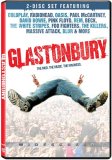| Reviews & Columns |
|
Reviews DVD TV on DVD Blu-ray 4K UHD International DVDs In Theaters Reviews by Studio Video Games Features Collector Series DVDs Easter Egg Database Interviews DVD Talk Radio Feature Articles Columns Anime Talk DVD Savant Horror DVDs The M.O.D. Squad Art House HD Talk Silent DVD
|
DVD Talk Forum |
|
|
| Resources |
|
DVD Price Search Customer Service #'s RCE Info Links |
|
Columns
|
|
|
Glastonbury
THE MOVIE:
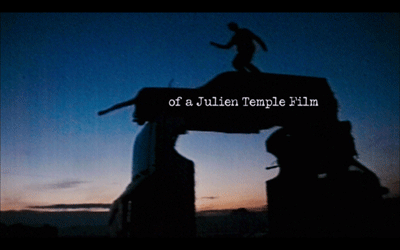
The Glastonbury Festival of Contemporary Performing Arts is an annual event in England that has been going on just about every summer since 1970. Three days and three nights with thousands of people camping out in a field to watch bands, indulge in substances of various kinds, and participate in communal arts explosions. Organized by farmer Michael Eavis, it's become an institution unto itself, tracing a long thread through British counterculture. There isn't much out there that would be comparable, that has been able to sustain for so long.
The legendary happening has a lot of history to be chronicled, much more than can be contained in one film. Director Julien Temple was willing to try, however. His documentary, simply titled Glastonbury, tries to cram the whole thing into two hours and fifteen minutes, giving a background on the festival while also showing performances from a large crop of bands and attempting to communicate the vibe of the event. For as exhilarating as Glastonbury can be, it can also be tedious. I get the sense that, faced with the sheer tonnage of footage to be culled into this movie, Temple fell prey to the Glasto vice. Like a festival-goer who has imbibed in too many illicit activities, he wanders through the massive field of information trying to remember where he set up his tent.
For the first hour or so, I was convinced that the director had struck documentary gold, finding a style that fit the size of his subject and managing to distill a lot of information into concise bites of footage. Temple has a filmography that includes a fair amount of music videos, as well as music-themed films, both documentary (Sex Pistols: The Filth and the Fury) and fictional (Absolute Beginners). The main draw of the Glastonbury weekend is its line-up of musical acts, and Temple works out a pattern of documentary segments interspersed with pieces of performances, juxtaposing the informational montages with the art to show us what it's all about. Some of his musical cues are brilliant, such as going from some petulant goings-on backstage to Bjork singing "Human Behavior," or using Radiohead's "Fake Plastic Trees" as the backdrop for the heavens opening and drenching the attendees with rain and mud (a pretty regular occurrence).
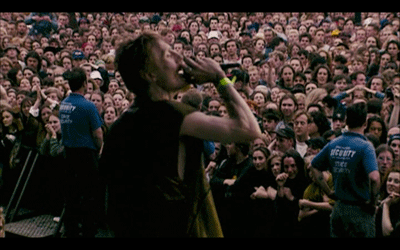
The structure of the film is loose. Though Temple does include a narrative line that follows the show over the decades, he blends all of the footage without marking any of it as being from any particular year. Though it's easy for the viewer to eyeball it and differentiate the newer from the older, he has still effectively made it so that Glastonbury doesn't document a series of individual concerts, but instead treats all four decades as if they were one ongoing performance. There through it all is Michael Eavis, a friendly, patient fellow. Though Temple never quite gets to why Eavis would go through the hassle year after year, the recurring presence of the man's chin beard is somehow reassuring.
Unfortunately, the only other constant through the whole thing are the festival attendees themselves, and this is where Temple is maybe overly indulgent. There are only so many scenes of crusty hippies and indie punks dancing that anyone ever really needs to see. Though he is trying to push the point that after three days of no showers and no sleep, the massive crowd becomes one community of music and muck, it grows tiresome. If you've seen one idiot in a giant foam hat, trust me, you've seen them all. Even the performance artists who pepper the audience start to become predictable and familiar. We get the gag. You either dress as some kind of stuffy authority figure or a giant bug. Ho-hum.
By some odd coincidence, the movie Glastonbury begins to lose the plot somewhere around the time in the narrative when the festival itself started to struggle. In the mid-'80s, Eavis embraced a convoy of "travelers" whose own alternative festival at Stonehenge had been brutally, violently broken up by police. Essentially a caravan of homeless street performers, Eavis allowed them to set up and provide the sidebar entertainment at the show. After squabbles over money and a Molotov cocktail-infused clash with thuggish security (shades of Gimme Shelter here), Eavis barred the travelers from the show. Once again, Temple is ready with a smart musical choice: the granola-caked Levellers, one of the worst bands in the history of British music, complaining about the banning from the performance stage.
From this point on, Eavis' decisions about the Festival are endlessly questioned and accusations of "selling out" regularly leveled as he has to give in to outside pressures and commercialization in order to keep the whole thing going. It seems in here there really is a story, one that Temple should have focused on rather than spending long amounts of time watching hippies shake their naked bits in the mud. A little more focus on keeping a narrative throughline would have worked wonders to pare this sprawling mess down. You wonder if at one point there was a plan for that, since the movie opens with a group of kids loading up their car to head out to the site. We return to them intermittently, but there never seems to be any point to their inclusion. We don't get to know them, we don't even know their names. They feel like an undeveloped afterthought. (And, as it turns out, this was shot by the kids themselves and taken from hours of home footage Glastonbury attendees contributed to this project.)
I also think much could have been done by giving the music an even stronger presence. A lot of bands get shown, and we see some great performances by the likes of Morrissey, Toots and the Maytals, Primal Scream, Blur, Faithless, Cypress Hill, Pulp, the Skatalites, David Bowie, Scissor Sisters, and many others (including Alabama 3, the guys who do the Sopranos theme, mislabeled as Primal Scream), but they are often just small excerpts of the songs. Why cut up Joe Strummer's incendiary runthrough of "Straight to Hell" where he starts banging on the BBC cameras with his microphone stand? Would it have had any less impact by letting this play in its entirety? Granted, this might have created an even greater unbalance between the documentary side of Glastonbury and the concert film side, but it did work for Woodstock, so no reason it couldn't be done here.
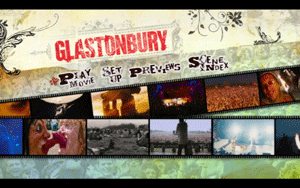
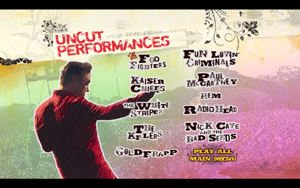
THE DVD
Video:
Glastonbury gets an excellent 16:9 picture transfer, anamorphically enhanced for widescreen TVs. Though footage from different eras show their age (both through the dilapidation of time and the clarity of modern technology), the editing is done well enough that one flows into the next without being jarring.
Sound:
The sound mix for the main feature comes in both a 5.1 and 2.0 English mix. Great care was clearly taken to have all the different pieces of the movie come through clearly. Whether we're witnessing the full performance of a rock band or some guy on an acoustic guitar in the middle of a sea of tents, they sound like they come from the same source. So, too, can we always hear the festival attendees when they speak.
English closed captioning is available.
Extras:
Glastonbury has been put together as a two-DVD set, and it's packed out with bonus features. Music fans will particularly want to take note of these items.
Besides trailers for other THINKFilm DVDs, disc 1 has a full-length commentary by director Julien Temple and musician Jarvis Cocker, the lead singer of one of my favorite bands, Pulp. Cocker and co. had some mythical Glastonbury appearances that helped propel his band to the forefront of British music in the 1990s, so he's a good choice to join Temple for a sit-down. Unfortunately, the track struggles to take off. Temple isn't particularly loquacious, and though Cocker can be a droll raconteur, the director doesn't give him much help, often sounding like he hasn't seen his own film. The singer's memories of playing there are somewhat interesting, but since he only attended one disastrous time as a fan, he doesn't have a lot to talk about as far as being in the crowd. Temple has some good anecdotes not used in the film and identifies some of what we see, but he doesn't keep it up. In short, the commentary is good at the times it sparks up, but it's too patchy. Note: It is worth skipping ahead to the Strummer incident to get some background on it and to Pulp's performance of "Common People" to hear Cocker discuss that particular night.
Disc 2 holds the rest of the extras. The main one is a gathering of ten uncut performances, only one of which, Nick Cave's sinister "Red Right Hand," is even excerpted in the movie. Radiohead check in for another performance, but it's of "Idioteque," a later period of their career than what was shown in the documentary. The other eight are very recent turns from Foo Fighters, Kaiser Chiefs, the White Stripes, the Killers, Goldfrapp, Fun Lovin' Criminals, Paul McCartney, and REM. The box promises a performance from Oasis, but that does not materialize. This section lasts 43 minutes.
Oasis' Noel Gallagher does show up in another extra, however, shooting off his mouth in his usual unrestrained fashion in a collection of 45 minutes of celebrity interviews from the festival. Other artists featured in this section are James Brown, Coldplay, Moby, the Dandy Warhols (with Ash's Tim Wheeler standing by), iconic radio DJ John Peel, and more with Michael Eavis (he takes up about half an hour of this particular section, the bulk of it). James Brown is particularly amusing, having never heard of Glasto before, whereas Moby has more experience with the event and predictably speaks in far more New-Agey terms about it. Of those interviewed, only Coldplay and James Brown (in a very brief cameo) show up in Glastonbury proper.
There are also three more bits of interviews (7:45) with attendees, labeled "Essex Boys" (a gaggle of middle-aged men), "Tattooed Man" (who in real life is actually a baker), and "Jimmy the Punk" (with requisite pink mohawk and day-glo Jesus shirt). These are pretty useless. The three subjects have little of interest to say and aren't even very distinctive as far as freaks go.
Two bonus documentary shorts--"Freeing the Spirit: Glastonbury 1999" (7 and a half minutes of lo-res video and lo-fi audio) and "Glastonbury Ceremony" (2:00)--show the more mystical side of the festival, with a Burning Man-like ritual and a prayer for peace.
Finally, there is the theatrical trailer for Glastonbury.
FINAL THOUGHTS:
Rent It. Julien Temple's documentary Glastonbury bites off more than it can chew by attempting to cram in the full history of four decades of a music and arts festival in under two-and-half hours. Still, excellent musical performances and the event's underlying story keep it watchable even as the constant tangential montages of stoned dancers get tedious. In all honesty, the movie probably plays better to music nerds than it does general audiences, and for those nerds among us, the second disc of bonus performances is probably close to enough on its own to have this in our DVD collection. Even with that, though, we're not likely to rewatch the film in its entirety very often. I'll probably be fast fowarding to the bits I like. So, music nerd, movie nerd, or neither, decide which side of the line you're on, and shop accordingly.
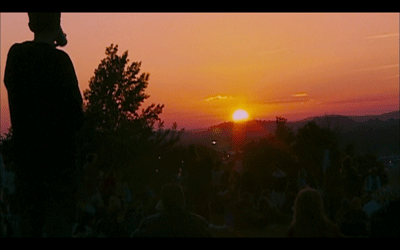
Jamie S. Rich is a novelist and comic book writer. He is best known for his collaborations with Joelle Jones, including the hardboiled crime comic book You Have Killed Me, the challenging romance 12 Reasons Why I Love Her, and the 2007 prose novel Have You Seen the Horizon Lately?, for which Jones did the cover. All three were published by Oni Press. His most recent projects include the futuristic romance A Boy and a Girl with Natalie Nourigat; Archer Coe and the Thousand Natural Shocks, a loopy crime tale drawn by Dan Christensen; and the horror miniseries Madame Frankenstein, a collaboration with Megan Levens. Follow Rich's blog at Confessions123.com.
|
| Popular Reviews |
| Sponsored Links |
|
|
| Sponsored Links |
|
|
| Release List | Reviews | Shop | Newsletter | Forum | DVD Giveaways | Blu-Ray | Advertise |
|
Copyright 2024 DVDTalk.com All Rights Reserved. Legal Info, Privacy Policy, Terms of Use,
Manage Preferences,
Your Privacy Choices | |||||||









